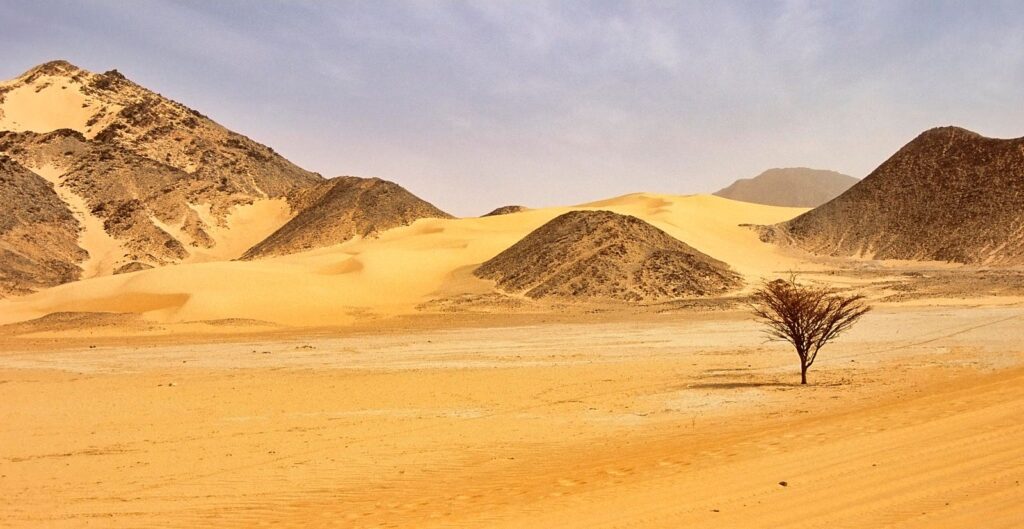
Most people envision the Sahara Desert as a vast, endless sea of sand dunes and shimmering heat. For most, this is an image that’s seemingly incompatible with life — and for the most part, they’re right. The Sahara stretches across nearly 3.6 million square miles of North Africa, and it’s one of the driest and harshest environments on Earth. Annual rainfall in most areas is less than an inch, and daytime summer temperatures regularly soar past 104°F (40°C).
Yet, life still finds a way. For decades, a solitary acacia standing hundreds of miles from its nearest neighbor came to symbolize survival itself in the Sahara. Known as the Tree of Ténéré, it was the most isolated tree on Earth. Its improbable existence captured the imagination of scientists, travelers, and even poets — until one unlikely event in 1973 brought its story to a tragic, almost absurd end.
The Tree of Ténéré: A Desert Phenomenon
The Tree of Ténéré once stood in northeastern Niger, near the town of Agadez, in a part of the Sahara well known for being incredibly arid. The area around it is called the Ténéré region, but it’s sometimes referred to as “the desert within the desert.” For hundreds of miles in every direction, there was nothing but sand — no shrubs, no grass, and certainly no other trees.
This is what made the tree’s presence so miraculous; it was all but completely isolated. The nearest vegetation of any kind lay more than 250 miles away. In fact, caravans relied on it as a navigational beacon, as it marked a vital stop along the ancient trans-Saharan trade routes. Before the advent of GPS or satellite mapping, this single tree served as a natural compass, likely guiding generations of Tuareg nomads and traders through one of the most treacherous landscapes on the planet.
Botanical Marvel
Botanically, the Tree of Ténéré was a subspecies of acacia (Vachellia tortilis raddiana) more commonly known as the umbrella thorn acacia. Unsurprisingly, as research from the Journal of Vegetation Science notes, this species easily adapts to some of the most unforgiving desert climates on the planet. Its wide, flattened canopy and incredibly deep root system (up to 35 meters, or 115 feet) are the specific features that make the acacia a master of water conservation.
How the seed arrived there exactly remains a mystery to this day. Some hypotheses suggest it may have germinated thousands of years ago when the Sahara was a much greener place. If true, it may have taken root during a part of the Holocene Wet Phase around 5,000 to 10,000 years ago, when this region of the Sahara once supported lakes, rivers, and savannas teeming with wildlife.
A Living Landmark in the Age of Exploration
By the early 20th century, the Tree of Ténéré had cemented its place in geographic legend. In 1939, it appeared on maps created by French military convoys, which referred to it as “L’Arbre du Ténéré.” Even pilots who crossed the Sahara by air, thousands of feet up, couldn’t miss its small green crown. After all, it was the only speck of life in a vast and sandy expanse.
Travelers often described the experience of seeing the lone tree as almost mystical. After days of monotony in the desert, the horizon being broken by a lone tree seemed to defy logic and physics entirely. If anything, it was thriving where no tree should even be able to survive.
Research from the Botanical Journal of the Linnean Society helps us to understand how such a large organism could survive in complete isolation. Most likely, it’s due to the acacia’s ability to close its stomata — the microscopic pores on their leaves — during the hottest parts of the day. This helps prevent water loss while maintaining their deep, intricate taproot systems.
The Tragic End of an Icon
For centuries, the Tree of Ténéré was seen as a kind of biological miracle — until 1973, when it met an almost unbelievable end. According to Nigerien authorities and the French military archives, a truck driver — who some sources allege to have been drunk — struck and uprooted the tree while driving through the desert.
The difficulty and sheer improbability of this feat cannot be overstated. This tree was the only obstacle in hundreds of miles of open terrain. Yet, be it due to shockingly poor navigation or a cruel twist of fate, the driver reportedly managed to hit it dead-on.
The damaged trunk was eventually transported to the National Museum of Niger in Niamey, where it remains preserved to this day. A year later, in 1974, the site where the Tree of Ténéré once stood was marked with a metal sculpture created by artist Philippe Minguet, shaped, of course, like a tree. Thankfully, this “metal tree” still stands today.
Other Famous Trees of the Desert
While the Tree of Ténéré may be the Sahara’s most legendary, it’s not the only tree to defy the odds in arid environments. Across the world’s deserts, a few other remarkable trees have achieved similar fame for their tenacity.
The Tree of Life in Bahrain
Located in the Persian Gulf nation of Bahrain, this 400-year-old Prosopis cineraria tree thrives in the middle of the desert with no visible water source. Its secret? A deep root system that taps into underground aquifers — and perhaps, symbiotic bacteria that enhance its nitrogen metabolism. For locals, it’s not just a botanical curiosity but a cultural icon, thought to represent the mythical Tree of Life described in ancient Mesopotamian and biblical texts.
The Arbre du Ténéré’s “Successor”
In Niger’s Aïr Mountains and the Tassili region, several acacias now grow under conservation protection, seen as symbolic heirs to the Tree of Ténéré. Local reforestation efforts, supported by the United Nations and Nigerien environmental agencies, aim to restore pockets of vegetation that could someday reconnect isolated patches of desert flora.
The Tombouctou Acacias
Near Timbuktu, Mali, a few ancient acacias mark the sites of old caravan routes. While not as solitary as the Tree of Ténéré, they serve a similar ecological role — stabilizing sand dunes, providing shade, and maintaining small oases of biodiversity in otherwise barren terrain.
The story of the Tree of Ténéré is a poignant reminder of nature’s resilience and the delicate balance required to sustain life in extreme environments. As conservation efforts continue in desert regions worldwide, the legacy of this remarkable tree endures, inspiring both scientific inquiry and cultural reverence.







